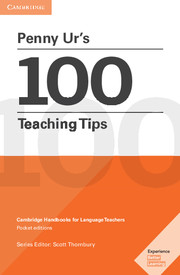Book contents
- Frontmatter
- Contents
- Why I Wrote this Book
- Beginning and Ending the Lesson
- The Coursebook
- Discipline
- Error Correction
- Games
- Grammar
- Group Work
- Heterogeneous (Mixed-Level) Classes
- Homework
- Interest
- Listening
- Pronunciation
- Reading Comprehension
- Speaking Activities
- Teacher Talk
- Testing and Assessment
- Vocabulary Teaching
- Writing
- P.S.
- Index
- Photo Acknowledgements
Speaking Activities
Published online by Cambridge University Press: 17 November 2023
- Frontmatter
- Contents
- Why I Wrote this Book
- Beginning and Ending the Lesson
- The Coursebook
- Discipline
- Error Correction
- Games
- Grammar
- Group Work
- Heterogeneous (Mixed-Level) Classes
- Homework
- Interest
- Listening
- Pronunciation
- Reading Comprehension
- Speaking Activities
- Teacher Talk
- Testing and Assessment
- Vocabulary Teaching
- Writing
- P.S.
- Index
- Photo Acknowledgements
Summary
A lot of students are very unwilling to speak English in the classroom because they’re shy, or worried about making mistakes, or afraid of losing face. So many either don't speak at all or use mother tongue instead of English. We need to think of ways to make it easier for them to participate.
72 Use language practice for fluency
73 Use group work
74 Let students use memorized text
75 Give tasks rather than topics
76 Make sure the language is easy
72 Use language practice for fluency
Often you can use standard grammar or vocabulary exercises as a basis for getting shy or lower-level learners to speak English.
Even the most mechanical grammar exercises, if done orally in the classroom, can give students basic speaking practice. Get students to say full-sentence answers out loud once and then when you’ve approved or corrected, tell them to repeat the sentence more quickly and smoothly without looking at their books.
Grammar or vocabulary activities that have more than one answer (are ‘open-ended’) and require creative oral responses will naturally give basic practice in speaking, as students are saying ‘their own thing’, even if this is grounded in a given sentence pattern. For example, if you are practising the comparative form of adjectives, give students a basic sentence like: ‘A car is faster than a bicycle’, then ask them to think of other ways of comparing a car with a bicycle. They might say ‘A car is more comfortable than a bicycle’ or ‘A bicycle is cheaper than a car’ and so on. You have given your students a basic pattern so have made things easier for them to construct their sentences – but they are choosing their own adjectives, and the nature of the task ensures that they must create meaningful sentences. (Theoretically, they could come up with nonsense sentences like ‘A car is wiser than a bicycle’, but this has never happened in my experience.)
If you use less structured cues, then of course students’ responses are more creative. For example, if you want students to practise the word disappointed, you might ask them to tell you about a time they were disappointed. Or if you want to practise the present perfect, you could invite them to tell you about things they have never done and would like to do.
- Type
- Chapter
- Information
- Penny Ur's 100 Teaching TipsCambridge Handbooks for Language Teachers, pp. 85 - 90Publisher: Cambridge University PressPrint publication year: 2016



